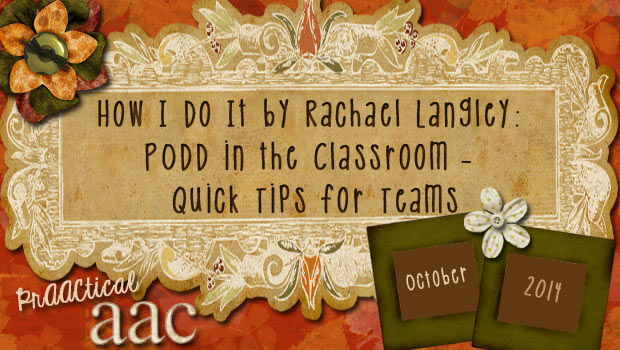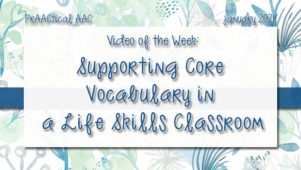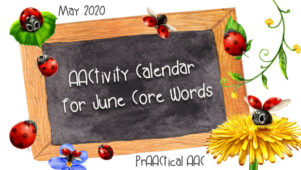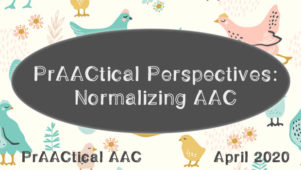How I Do It with Rachael Langley: PODD in the Classroom – Quick Tips for Teams

Today we welcome SLP Rachael Langley, who has been working in the public schools as a speech-language pathologist for over 12 years. Currently working as an AAC Specialist in Mid-Michigan, Rachael tells us that she strives to spread the message about the importance of AAC and unlocking the communication potential of all students. In this post, Rachael shares some of her best tips for building communication with learners who are getting started with PODD books.
The PODD system offers a complete language approach through carefully organized symbol sets. Because the PODD system promotes a language immersion model, there is no pressure on our language-learners reproducing specific words or patterns at a specific rate. Here are some quick tips I share with classroom teams who are starting out with PODD:
- Input before output! Model, model, model! – Without digging too deep into the importance of Aided Language Stimulation, we want to make sure the team knows how responsibility for learning and speaking PODD falls first upon the team members. The students will begin to engage with PODD as they see PODD in action.
- “I have something to say!” – We must model how to initiate using PODD. Those modeling PODD will raise and wave a hand while stating, “I have something to say!” Our students do not have the ability to pair a sentence with the hand motion, but each learner will have their own version of an initiating behavior.
- First 2 Weeks, First 2 Pages – As a new team is first learning PODD, they are usually overwhelmed looking at the number of symbols and total pages in a PODD book. As the classroom team is learning the book and introducing it to the students, they are encouraged to stick to ONLY the first two pages of the book. In these first two pages are plenty of opportunities to comment and practice building our own motor memory for frequently used symbols. After the initial two weeks, the team selects a section or a “branch” to add to the phrases they have been practicing.
- You point, I turn – Some of our complex communicators really want to grab that book. They love the symbols, flipping the pages, etc. Since PODD is a partner-assisted communication system, the adults on the team will be controlling the PODD books. If the students grab or try to turn, we redirect with “You point, I turn.” The partner is happy to help the student navigate through the book. But the student’s only responsibility is pointing — plus retaining the message that they’re working to communicate. Let the adults be concerned with navigating between sections, remembering which symbols have been selected so far, etc.
All of these tips (and much more) were gleaned from a series of trainings with Laura Taylor, Linda Burkhart, and the creator of PODD – Gayle Porter. I always encourage teachers and other team members to attend a PODD overview or official training, whenever possible. In the meantime, these key starting points are helpful in getting started.
Filed under: PrAACtical Thinking
Tagged With: classroom, PODD, Rachael Langley
This post was written by Carole Zangari






4 Comments
Nice overview of my favorite tips! One other important point… When I tell people to focus on the first two pages for the first couple of weeks I invariably get asked if they can carry *just* those two pages to make it “easier”. The short answer is no. The team has to work through how to manage the book throughout the day and problem solve issues around how to make the book accessible to the student at all times. So, I always add that the team needs to carry the book everywhere the child goes. That and using the first two pages of the book are a good way to get started!
Great point, Jeanne! Thanks for taking the time to comment so that we don’t overlook that important detail. I’m sure it will save some confusion out in the trenches. 🙂
Great post I was able to use with a school straight away this week. Thanks!
Yay for good timing!!